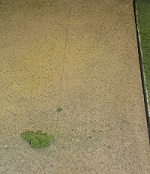Protecting a Foam Module Top from Compression Damage
by Steve Gillett
The use of extruded foam on top of modules is now very popular. Many N-Trak modules have a sheet of ½” or ¾” foam
glued to the ½” plywood module top allowing for landscape contours below the track grade. Extruded foam is fairly
rigid and, if accidental compressed, it will not rebound to its previous shape. Accidental compression of the foam
is generally not a problem, since true ground areas are rarely flat anyway.
However, foam compression can become a problem when occurs under the area where the rail joiner tracks are installed.
Without firm, flat support underneath them, the joiner tracks can sag as trains pass over them, thereby causing
uncoupling, derailment or other problems. Some module builders place a 2’ long piece of 1” x 4” hardwood flat along
each end of the module to protect an area 3½” in from each side and which fits flush with the ¾” thick foam that
covers the rest of the module. Unfortunately, wood and extruded foam have different coefficients of expansion and
therefore, over time, cracks appear in the module’s ground cover along the seam between wood and foam. (Figure 1)













